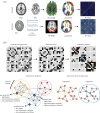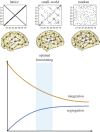Understanding principles of integration and segregation using whole-brain computational connectomics: implications for neuropsychiatric disorders
- PMID: 28507228
- PMCID: PMC5434074
- DOI: 10.1098/rsta.2016.0283
Understanding principles of integration and segregation using whole-brain computational connectomics: implications for neuropsychiatric disorders
Abstract
To survive in an ever-changing environment, the brain must seamlessly integrate a rich stream of incoming information into coherent internal representations that can then be used to efficiently plan for action. The brain must, however, balance its ability to integrate information from various sources with a complementary capacity to segregate information into modules which perform specialized computations in local circuits. Importantly, evidence suggests that imbalances in the brain's ability to bind together and/or segregate information over both space and time is a common feature of several neuropsychiatric disorders. Most studies have, however, until recently strictly attempted to characterize the principles of integration and segregation in static (i.e. time-invariant) representations of human brain networks, hence disregarding the complex spatio-temporal nature of these processes. In the present Review, we describe how the emerging discipline of whole-brain computational connectomics may be used to study the causal mechanisms of the integration and segregation of information on behaviourally relevant timescales. We emphasize how novel methods from network science and whole-brain computational modelling can expand beyond traditional neuroimaging paradigms and help to uncover the neurobiological determinants of the abnormal integration and segregation of information in neuropsychiatric disorders.This article is part of the themed issue 'Mathematical methods in medicine: neuroscience, cardiology and pathology'.
Keywords: brain connectivity; computational modelling; integration and segregation; network analysis; neuropsychiatric disorders.
© 2017 The Author(s).
Conflict of interest statement
We declare we have no competing interests.
Figures







Similar articles
-
Great expectations: using whole-brain computational connectomics for understanding neuropsychiatric disorders.Neuron. 2014 Dec 3;84(5):892-905. doi: 10.1016/j.neuron.2014.08.034. Neuron. 2014. PMID: 25475184 Review.
-
Structural connectomics in brain diseases.Neuroimage. 2013 Oct 15;80:515-26. doi: 10.1016/j.neuroimage.2013.04.056. Epub 2013 Apr 25. Neuroimage. 2013. PMID: 23623973 Review.
-
Towards a Quantified Network Portrait of a Population.Inf Process Med Imaging. 2015;24:650-61. doi: 10.1007/978-3-319-19992-4_51. Inf Process Med Imaging. 2015. PMID: 26221710 Free PMC article.
-
The hubs of the human connectome are generally implicated in the anatomy of brain disorders.Brain. 2014 Aug;137(Pt 8):2382-95. doi: 10.1093/brain/awu132. Epub 2014 Jun 19. Brain. 2014. PMID: 25057133 Free PMC article.
-
[Diffusion formation and psychiatric diseases].Radiologe. 2015 Sep;55(9):782-7. doi: 10.1007/s00117-015-0009-2. Radiologe. 2015. PMID: 26286437 German.
Cited by
-
Resting-state network topology and planning ability in healthy adults.Brain Struct Funct. 2020 Jan;225(1):365-374. doi: 10.1007/s00429-019-02004-6. Epub 2019 Dec 21. Brain Struct Funct. 2020. PMID: 31865409 Free PMC article.
-
Topological Data Analysis Reveals Robust Alterations in the Whole-Brain and Frontal Lobe Functional Connectomes in Attention-Deficit/Hyperactivity Disorder.eNeuro. 2020 May 12;7(3):ENEURO.0543-19.2020. doi: 10.1523/ENEURO.0543-19.2020. Print 2020 May/Jun. eNeuro. 2020. PMID: 32317343 Free PMC article.
-
Nonlinear changes in delayed functional network topology in Alzheimer's disease: relationship with amyloid and tau pathology.Alzheimers Res Ther. 2023 Jun 16;15(1):112. doi: 10.1186/s13195-023-01252-3. Alzheimers Res Ther. 2023. PMID: 37328909 Free PMC article.
-
Brain Structure and Function: Insights from Chemical Neuroanatomy.Life (Basel). 2023 Apr 3;13(4):940. doi: 10.3390/life13040940. Life (Basel). 2023. PMID: 37109469 Free PMC article.
-
Cholinergic neuromodulation of inhibitory interneurons facilitates functional integration in whole-brain models.PLoS Comput Biol. 2021 Feb 18;17(2):e1008737. doi: 10.1371/journal.pcbi.1008737. eCollection 2021 Feb. PLoS Comput Biol. 2021. PMID: 33600402 Free PMC article.
References
Publication types
MeSH terms
Grants and funding
LinkOut - more resources
Full Text Sources
Other Literature Sources
Medical

